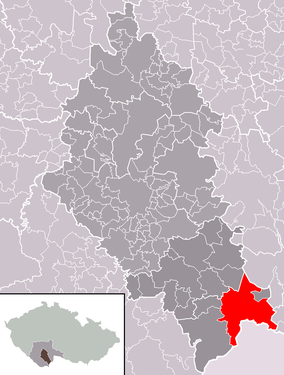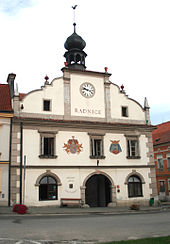Nové Hrady
| Nové Hrady | ||||
|---|---|---|---|---|
|
||||
| Basic data | ||||
| State : |
|
|||
| Historical part of the country : | Bohemia | |||
| Region : | Jihočeský kraj | |||
| District : | České Budějovice | |||
| Area : | 7972 ha | |||
| Geographic location : | 48 ° 47 ' N , 14 ° 47' E | |||
| Height: | 541 m nm | |||
| Residents : | 2,524 (Jan 1, 2019) | |||
| Postal code : | 373 33 | |||
| License plate : | C. | |||
| traffic | ||||
| Street: | Trhové Sviny - Weitra | |||
| Railway connection: | České Budějovice – Gmünd Lower Austria | |||
| structure | ||||
| Status: | city | |||
| Districts: | 8th | |||
| administration | ||||
| Mayor : | Vladimír Hokr (as of 2018) | |||
| Address: |
náměstí Republiky 46 373 33 Nové Hrady |
|||
| Municipality number: | 544868 | |||
| Website : | www.novehrady.cz | |||
| Location of Nové Hrady in the České Budějovice district | ||||

|
||||
Nové Hrady (German Gratzen) is a city in the Czech Republic . It belongs to the South Bohemia region .
geography
Nové Hrady is located in southern Bohemia at the confluence of the Novohradský potok with the Stropnice . The city is located in the ridges of the Gratzener mountain range of the same name ( Novohradské hory ), north of the city is a pond landscape. Two kilometers southeast of Nové Hrady, the road to Pyhrabruck crosses the internal border with Austria and reaches the neighboring community of Unserfrau-Altweitra .
history
A Slavic castle complex is said to have been there as early as 980. The first documentary mention comes from May 21, 1279, when Hogyrius de Gretzen (Hojer von Gratzen; Ojíř z Nového Hradu ) from the Witigon branch of the Landstein can be proven as the owner of the Nové Hrady castle . In 1291 Gratzen was owned by the Smil von Gratzen, who in that year donated the church of Deutsch-Reichenau to Hohenfurt Abbey . In 1359 the Rosenbergs acquired Gratzen from Ojíř / Hojer and Vítek / Witiko von Landstein.
The exact time when the settlement below the castle was elevated to the status of a town is not known. It is believed that this took place in the 14th century during the time of Ulrich I von Rosenberg , who also founded the Gratzen rule and had the ponds built north of the city. When he died in 1390, the surrounding villages belonged to the Gratzen rule. Under his son Heinrich III. from Rosenberg the city grew rich. In addition to selling the wood from the surrounding forest areas and making shingles, the residents lived primarily from growing hops and brewing. The Gratzener beer was delivered to the entire Rosenberger domain.
In 1425 the Hussites invaded under Jan Hvězda z Vícemilic and burned the town and castle down. During the uprising against Georg von Podiebrad , the troops of Zdenkos von Sternberg pillaged the town and castle again in 1467. At the beginning of the 16th century, Gratzen experienced its heyday, breweries were set up in several of the surrounding dominant villages, such as Weißbach, Niederthal and Sonnberg . In 1521 the large pond ( Byňovský rybník ) was created at Böhmdorf and in 1568 the ponds at Gabernost and Sohors were connected to form a large, today's Žárský rybník (Sohorser pond). Glass production was also established, in 1564 the first glassworks of the Gratzener rule was founded in Piberschlag, and in 1588 the Wilhelmsberg glassworks near Heilbrunn followed.
At that time, the estate was owned by Wilhelm von Rosenberg and his brother and successor Peter Wok , the last of the Rosenbergs. At the end of the 16th century, the Rosenbergs rebuilt the old castle, which was in poor condition. After Peter Wok's death in 1611, Gratzen came into the possession of Johann Georg von Schwanberg . Until 1620 the rule then belonged to Peter von Schwanberg, who pledged it and whose property was finally confiscated because of his participation in the class uprising of 1618. On February 6, 1620 Ferdinand II gave the rule of Gratzen to his general Charles Bonaventure de Longueval, Comte de Bucquoy .
In 1708, the Servite Monastery was built in the center of the city. At the beginning of the 19th century, further glassworks were built in Niederthal and Georgenthal . In 1802 the construction of the New Palace began on the road to Gmünd , which was completed in 1810 under Georg Franz August von Buquoy and in which a palace theater played between 1832 and 1836. In 1852 the first machine-operated cutting mill went into operation in Jakule. Coming from Buchers , reverse glass painting found its way into Gratzen.
After the patrimonial jurisdiction was abolished, Gratzen became the seat of a district court, received a post and telegraph office and a gendarmerie station. The population quadrupled almost within half a century from 1272 (1846) to 4525 (1900). During this time, the construction of the railway from Pilsen to Vienna also fell , the route of which from 1869 passed five kilometers northeast of the city and was given a train station near Jakule.
In 1900 the city of Gratzen had 1,596 inhabitants within its borders at that time, of which 1,451 were German-speaking and 33 were Czech-speaking.
After the fall of the Austro-Hungarian monarchy, Gratzen became part of Czechoslovakia in 1918 . The resulting border situation had a very negative effect on the city. This also contributed to the fact that the Gratzen rulers referred to themselves as choulostivý místo republiky (most unfortunate place in the republic ) in official bodies . On July 31, 1920, the villages of Naglitz, Thiergarten and Weißenbach were ceded to Czechoslovakia from the Austrian district of Gmünd through the new border definition.
In 1930 the city had 1,264 inhabitants, of which 913 were German and 351 Czech.
After the Second World War , the German population was expelled and the Counts of Bucquoy were expropriated. The later onset of the Cold War and the erection of the Iron Curtain led to the desolation of the Gratzener Land, which was now at the end of the ( socialist ) world, close to the border fence, whereby numerous villages were left to decay.
After the Velvet Revolution and the opening of the border with Austria, the rebuilding of the neglected infrastructure began and the city redeveloped its historic buildings. The surrounding Gratzener Bergland was opened up for tourism again.
Community structure
The town of Nové Hrady consists of the districts Byňov (Böhmdorf), Nakolice (Naglitz), Nové Hrady , Obora (Thiergarten), Štiptoň (Winau), Údolí (Niederthal), Veveří (Piberschlag) and Vyšné (Weißenbach). To Nové Hrady also includes the residential places Cuknštejn (twitching stone), Fischerovy Chalupy (Fischer yards), Hlinov (Tonnberg), Hranice (Granitz), Jakule , Jandovka (the fire), Janovka I (Johannesruh) Kapinos (Gabernost), Karlov (Karlberg ), Klín (Kling), Terezín (Theresienthal), Tomkův Mlýn and U Kollerů as well as the desert areas Jedlice (Göllitz) and Mýtiny (Kropfschlag). Basic settlement units are Byňov , Hlinov , Jakule , Janovka I , Mýtiny , Nakolice , Nové Hrady , Obora , Štiptoň , Údolí , Veveří and Vyšné .
The municipality is divided into the cadastral districts of Byňov, Mýtiny, Nakolice, Nové Hrady, Obora u Vyšného, Štiptoň, Údolí u Nových Hradů, Veveří u Nových Hradů and Vyšné .
Attractions
- The Nové Hrady Castle , built in 1277 by the Witigonen , was reopened to visitors in 2000 after the renovation work was completed.
- The three-winged castle Nové Hrady , built between 1802 and 1810 in Empire style , belonged to the Counts of Bucquoy until 1945. Its furnishings included a theater and a conference room, which was designed to resemble a general's tent from the Thirty Years' War. The castle and the adjoining buildings are now owned by the Academy of Sciences of the Czech Republic, which operates a research center in the field of life sciences here together with the University of South Bohemia in České Budějovice . The palace gardens are open to the public, and cultural events are occasionally held in the palace theater or the hall of mirrors.
- The Church of St. Peter and Paul was built in 1284 and was rebuilt from 1679 to its present form; the old Bucquoy family crypt from 1648 (stone in the presbytery).
- The former Servite monastery was founded in 1677 by Gotthard von Bucquoy. In doing so, after his recovery, he kept a promise he had made in 1664 after being seriously wounded in the battle of the Turks near St. Gotthardt an der Raab . The baroque building was given its present form in 1708.
- The Gossing Forge ( Novohradská kovárna ) was established in 1719 by the Gossinger family of blacksmiths. It was operated until 1879 and then used as a residential building. In 2000 the city bought the dilapidated building and renovated it. In the forge there are demonstrations of the old blacksmith's craft in the summer months and on public holidays.
- The city pharmacy with its baroque furnishings
- The city gate
- The stone fountain in the market square from 1744
- The neo-Gothic family crypt of the Counts Bucquoy, built between 1890 and 1892, architect Josef Schulz
- The town hall from 1536, built in the Renaissance style
- City residence of the Counts of Bucquoy, older Häser from 1634 bought by Maria Magdalene Bucquoy and converted into a city palace
- The Theresiental ( Terčino or Tereziino údolí ), a forest park established under Theresa von Bucquoy, with a spa house for the countess built between 1788 and 1797, which was expanded in 1817 by a waterfall and the Schweizerhaus built in 1852.
- Cuknštejn Castle , a fortress built by Vilém Pouzar z Michnic between 1481 and 1490 above the Theresa Valley
Personalities
sons and daughters of the town
- Robert Martinek (1889–1944), Austrian officer, later an officer in the German Wehrmacht
- Carl Hahn senior (1894–1961), German automobile manager at Zschopauer Motorenwerke JS Rasmussen and Auto Union
- Johann von Oppolzer (1808–1871), physician
Other personalities
- Theobald Hock lived in Gratzen in 1610 as a guest of Peter Wok von Rosenberg.
- Georg Franz August von Buquoy lived in the New Palace from 1832 to 1836.
literature
- Friedrich Schattauer: Historical walks in the old homeland - The city of Cratzen from the beginning to the beginning of the 20th century in Das Waldviertel , 1985 / 07-08-09, p. 142ff. ( Digitized version )
Web links
Individual evidence
- ↑ http://www.uir.cz/obec/544868/Nove-Hrady
- ↑ Český statistický úřad - The population of the Czech municipalities as of January 1, 2019 (PDF; 0.8 MiB)
- ↑ Valentin Schmidt and Alois Picha: Document book of the city of Krummau in Bohemia . I. Volume. 1253-1419. Prague, 1908, p. 7
- ^ KK Central Statistical Commission, Community encyclopedia of the kingdoms and countries represented in the Imperial Council. Edited on the basis of the results of the census of December 31, 1900. Volume IX Bohemia (Vienna 1904) p. 272.
- ^ Rudolf Hemmerle : Sudetenland Lexikon Volume 4, page 173. Adam Kraft Verlag, 1985. ISBN 3-8083-1163-0 .
- ↑ http://www.uir.cz/casti-obce-obec/544868/Obec-Nove-Hrady
- ↑ http://www.uir.cz/zsj-obec/544868/Obec-Nove-Hrady
- ↑ http://www.uir.cz/katastralni-uzemi-obec/544868/Obec-Nove-Hrady




